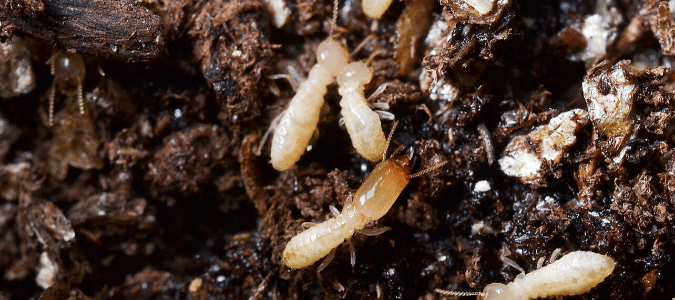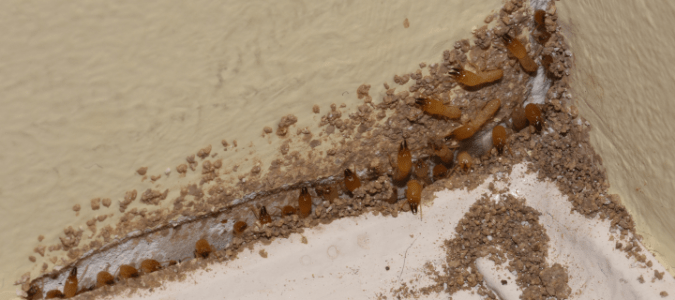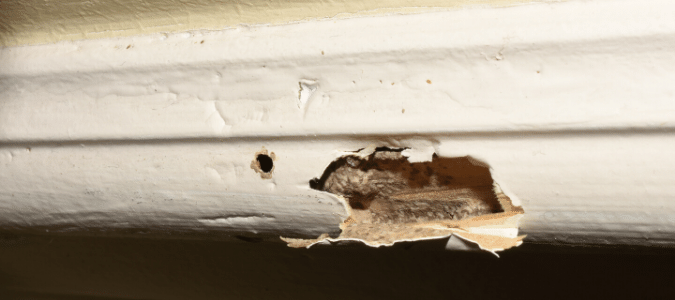While an infestation of something like cockroaches, ants, or spiders might be more apparent, knowing whether your home is housing termites can be more difficult.
For many people, it takes uncovering damage to wood during construction or seeing a swarm to raise the issue of a termite infestation. These insects are largely silent, hard to discover, and found in every U.S. state except for Alaska, where temperatures are too low for termites to survive. Because of how widespread this pest is and the extreme damage it can cause before being discovered, termites cause more than $50 billion in property damage yearly.
How To Tell if Termites Are Active
Termites aren’t a problem you can fix on your own. A licensed pest control professional will be able to inspect your structure and determine whether:
- You have termites.
- There was a previous termite issue that is no longer a threat.
- Your home or other structure has an infestation of another type of wood-destroying insects, such as carpenter ants.
Once you know what you are facing, you and your pest control pro can develop a game plan to handle an active infestation, prevent a new one and fix the damage that has already occurred.
An easier and more useful way to determine if you see ants or termites is to call in a licensed pest control professional. They will be able to determine what pest is swarming, and then they can provide you with a proper treatment plan.
Common Signs of a Termite Infestation
You might not see flying insects but check around your closed doors and windows in the spring. Reproductive termites shed their wings after they emerge from the nest to create a new colony, leaving a calling card near these usual entrance points to a home. They no longer need their wings.
Termite damage can look like wood rot. Also, be on the lookout for termite droppings, also called frass. Frass is piles of pellets that look like sawdust. The termites push their waste out of their mud tubes in order to keep their living quarters clean.
If your floors are blistering, as they would with water damage, but there is no water damage to be seen, this is another telltale sign of a termite infestation. With so many variables to account for when you suspect termites, the best thing to do is call in a licensed pest control professional.
What Color Are Termites?
At first glance, it can be hard to differentiate between carpenter ants and termites. They can vary in color from brown to black, yellow, or cream, and are anywhere from half a centimeter to two centimeters long.
First, look at the wing length. Ants’ front wings are longer than their hind wings, whereas all of the wings on a termite are of fairly equal length. Antennae shape is another tell. Ants’ antennae are bent about 90 degrees, and termites’ are straight or may droop slightly.
A licensed pest control professional can easily find the source of your concern, tell you if you have termites, determine the extent of your damage or infestation and tell you what needs to be done. They will even recommend a course of treatment to prevent infestations in the future.
Where Are Termites Found?
There are several types of termites, and they draw their names from where they can be found. Dampwood termites reside in decaying wood with high moisture content. They need moisture for food and as a place to build their nests. You would be more likely to find these termites in places like rotting trees than in your home.
Drywood termites, as you might suspect, like to build their nests in dry wood. That makes the inside of a home’s walls and the inside of a roof a couple of their top spots to live. You will also find dry-wood termites in dry logs and dead trees in nature.
Then there are subterranean termites. These termites live inside the mud tubes they create for travel above ground. Subterranean termites can’t build their nests inside any wood. They will move through their system of mud tubes in search of wood to eat, and they often find it in human-built structures. They can also enter homes and other structures through cracks in foundations.
Strategies for Termite Prevention
An even better strategy is to set up a yearly termite inspection to stay ahead of potential issues. Checking for mud tubes or other termite signs should be on every homeowner’s maintenance checklist.
You can do some things to help prevent termites from targeting your home. The top of the list is to remove water sources such as leaking pipes or clogged gutters and downspouts. If you keep firewood near your home for a wood-burning fireplace or fire pit, don’t set it up or lean it against the exterior wall. Leave some room away from exterior walls and away from the roof to make your home less attractive to pests.
It’s also important to keep the soil around your foundation dry. This might mean getting a crew in to properly grade your yard and ensure the soil drains away from the foundation. If you notice a water leak, whether at a faucet that runs inside or outside, get it fixed immediately.
Termite Treatment
Treatments to fight termites come in several forms, from liquids applied to the soil to termite baits and even building materials that are built to repel these pests. These types of treatments are regulated by the federal government and can only be used by a licensed professional.
With proper inspection and some planning, you can help make your home and other structures less attractive to termites. If they do find a place to nest, don’t fret. A licensed pest control exterminator can assess the threat, treat the problem and then work with you to set up a maintenance plan that will keep termites from returning in the years to come.
ABC Can Help With All of Your Pest Problems
Finding termites on your property can be terrifying. These pests are destructive, and their colonies can be in the thousands. If you believe you have termites on your property, contact ABC Home & Commercial Services. Our professionals will be able to locate the termite colony and then implement an effective termite control plan.


